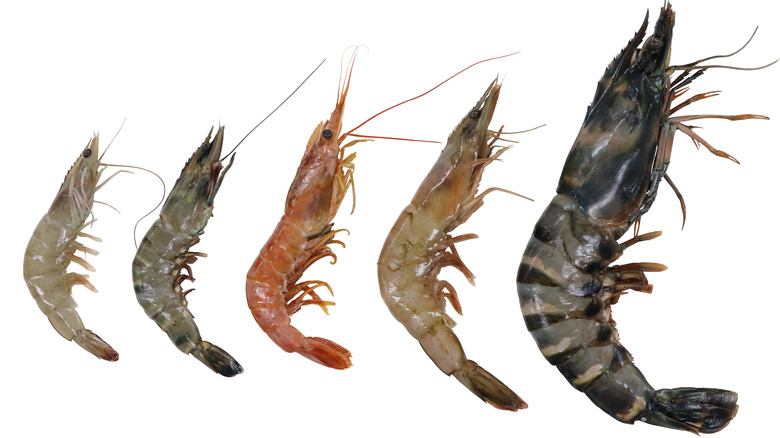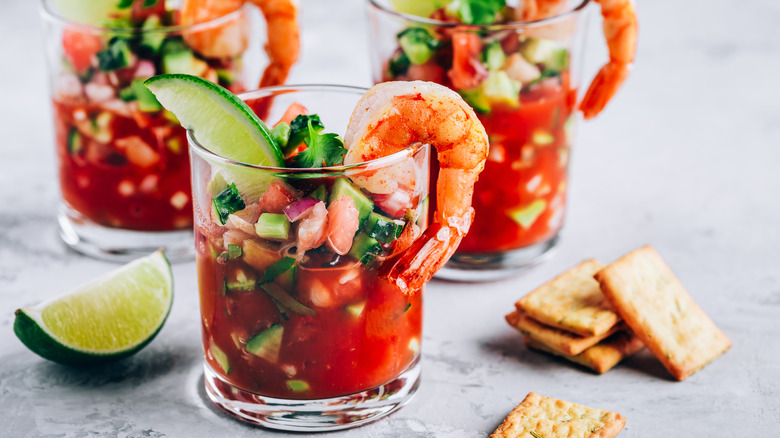Ina Garten's Foolproof Advice For Buying Shrimp
Purchasing seafood can sometimes be confusing, especially when distinguishing between farm-raised, wild-caught, and sustainable options. When buying shrimp, additional labels only add to the uncertainty with fresh, frozen, or previously frozen options available in a half-dozen sizes.
Leave it to Ina Garten to help us all out. In her 2018 book, "Cook Like A Pro," the Barefoot Contessa offers foolproof advice when buying shrimp that simplifies the process. Garten suggests ignoring the sizes that classify shrimp from tiny to colossal. According to her, that indication is arbitrary and isn't regulated by the industry, so it can change between sellers.
Labels, for instance, will state "U-10," meaning there are 'under' 10 shrimp in a pound. The shrimp size can also be displayed as "11/15," meaning there are between 11 and 15 of this size shrimp in one pound. Shrimp are weighed with their shells on but not their heads. In general, the lower the number, the larger the shrimp.
Rather than deciphering all of that, the chef advises instead to order shrimp by how many pieces you want per pound (it's good advice for purchasing scallops, too).
When to use different sized shrimp
Shrimp is a delicious, quick protein to prepare. Depending on the recipe, you may prefer one size of the seafood over another, but it's important to know how much you're getting, per Ina Garten's tip about focusing on the quantity.
The smallest-sized shrimp are labeled as baby or mini shrimp and typically contain over 50 shrimp per pound. Due to their tiny size, these shrimp are commonly sold peeled and deveined, which makes them easy to cook with such as in popcorn shrimp recipes and flavorful stir-fries.
Small shrimp contain around 36 to 45 in a pound. They are best suited for shrimp boils (Lowcountry or Tidewater), fritters, and fried rice since you can eat the entire crustacean in one bite.
Medium shrimp are typicaly labeled 31/35. This range is ideal for dishes that showcase the crustacean such as in risotto, paella, and pasta recipes like shrimp scampi. Mixed with mayonnaise and fresh herbs, medium shrimp are also perfect for shrimp salad rolls.
The next size, commonly called large shrimp, contains around 21 to 30 pieces in a pound. Batter and deep fry this size for crispy fried shrimp platters and po'boy sandwiches.
Jumbo or 11/15 options are meatier and ideal for shrimp cocktail recipes, whether you poach or roast the shrimp (as Garten does).
The largest size, U-10, is often called colossal shrimp, and they are best for stuffing or grilling. Their large size won't slip between the grates and is more forgiving over high heat, which can quickly overcook smaller shrimp.
Additional shrimp buying tips
In addition to Ina Garten's tip regarding quantity, the quality of shrimp and its sourcing is important. Fishmongers in the US usually label whether the fish is farmed or wild-caught, but are not required by the United States Department of Agriculture to indicate where the seafood was caught, which has significant environmental implications that are important to some consumers (you can always check the Environmental Protection Agency's website for an updated list of advisories).
When buying the freshest quality, unless you can purchase it live, frozen shrimp are generally fresher than shrimp labeled fresh at the market. It may seem counterintuitive, but fishermen immediately place the freshly caught shrimp on ice, preserving the crustacean's flavor and texture within hours of being captured.
Fresh shrimp sold by a fishmonger is likely previous frozen shrimp that has been thawed for purchase. Since it's hard to tell how long this shrimp has been defrosted, the highly perishable food won't be as fresh as the bag of frozen shrimp you thaw at home.
Also, it's good to keep in mind if you're trying to decide how many shrimp to serve per person — once shrimp are defrosted, they can lose 10% to 20% of their total weight. Like other proteins, once cooked, they further shrink a whole size, leaving colossal to resemble jumbo shrimp on the plate. In addition, if you purchase raw shrimp with the shell on, once peeled and cooked, one pound can be reduced to half a pound, so it's best to figure out how much you need before heading to the market.



